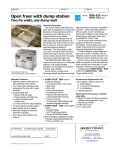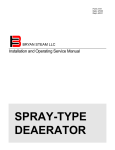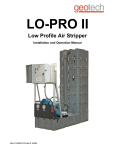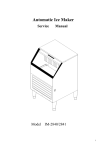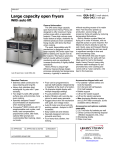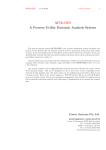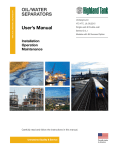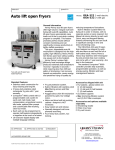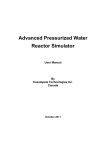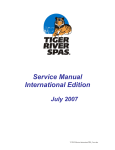Download HEI DEAERATOR TROUBLESHOOTING GUIDE
Transcript
#105 HEI DEAERATOR TROUBLESHOOTING GUIDE This troubleshooting guide is an excerpt from the 7th edition of the Standards for Typical Specifications for Tray Type Deaerators and has been prepared to assist operators of deaerators. The guide provides general guidance, and operators are advised to consult with the manufacturer when necessary for specific instructions regarding their equipment. Many of the items listed below are not in the scope of the deaerator manufacturer; however, these items do affect operation and must be considered by operators. The troubleshooting guide refers to sections in the 7th edition of the Standards for Typical Specifications for Tray Type Deaerators for additional information. The standard is available through the HEI office and can be ordered by contacting the HEI at [email protected]. or 216241-7333. Symptom High O2 Possible Causes -Air in-leakage -Insufficient stabilization period* -Trays not installed properly and in place -Not steady state conditions* -O2 inlet not in accordance with specified design conditions -Spray valves not installed correctly -Water inlet temperature too low -Improper venting -Incorrect testing -Operation outside of design conditions Comments or Possible Solutions -See test procedures in section 7.4 -Loose fittings -Shut scavenger off -Remove chemical interferences -Verify design conditions *Often, high oxygen measurements can be traced to inadequate test procedures. In order to conduct a proper test, it is important that there be a sufficient stabilization period and steady state conditions. The proper length of a stabilization period is extremely dependent on system-specific conditions, particularly the size of the system. Therefore, while three days of boiler operation are typically required to reach steady state, no definitive guidelines can be given. As a general rule, if there is a downward trend in oxygen content measurements, steady state condition has not yet been attained. **Shading is provided for the ease of reading only. This Tech Sheet was developed by the members of the Heat Exchange Institute’s (HEI) Deaerator Section. HEI is a trade association comprising the leading manufacturers of heat exchange and vacuum equipment. HEI Tech Sheets are information tools and should not be used as substitutes for instructions from individual manufacturers. Always consult with individual manufacturers for specific instructions regarding their equipment. 3/24/03 Page 1 of 2 This sheet is reviewed periodically and may be updated. Visit www.heatexchange.org for the latest version. #105 Symptom Excessive Pressure Fluctuation Possible Causes -Steam PRV improperly sized or calibrated -Improperly sized downcomer and equalizer -Inlet steam pressure too high or too low -Improper pilot installation -Excessive inlet temperature variation -Heater flooding -Incorrect thermometer reading -Insufficient steam flow Low Outlet Temperature -Incorrect steam/water ratio -Spray valves or internals malfunctioning -Heater flooding -Inlet flows piped incorrectly -Inlet flows mixing just prior to deaerator inlet Water Hammer High CO2 -Improper pipe design -High inlet velocities -High CO2 at inlet -High pH -Improper venting Tray Upsets -Tray hold down not secure -Turbine trip -Flashing Unexpected Storage Tank Level Excursions -Malfunctioning level control system -Malfunctioning overflow or improper boiler feed pump operation -Pressure fluctuations Water Out of Vent -Cracked vent welds -Improper vent piping Iron Oxide in Deaerator -Water carryover -Condensate or system corrosion -Frequent shutdowns -High O2 Comments or Possible Solutions -Check size and calibration -Keep within design range -Check all valve and control settings -Check calibration -Check steam supply -Check for restrictions -Check pipe and valve sizing -Check heat and mass balances -Check spray valves, trays, etc. -Check all valve and control settings -Check all inlet flows and temperatures -Mix flows farther upstream of deaerator -Check and/or redesign -Keep within HEI -Verify CO2 design condition -Lower pH -Review vent system -Install correctly -Gradual increase/decrease of controlled flows -Check setting and system operation -Check overflow level and boiler feed pump operation -Refer to “Excessive Pressure Fluctuation” -Repair or redesign -Should be as short and as vertical as possible -Reset vent flow -Keep positive pressure on deaerator -See “High O2” **Shading is provided for the ease of reading only. This Tech Sheet was developed by the members of the Heat Exchange Institute’s (HEI) Deaerator Section. HEI is a trade association comprising the leading manufacturers of heat exchange and vacuum equipment. HEI Tech Sheets are information tools and should not be used as substitutes for instructions from individual manufacturers. Always consult with individual manufacturers for specific instructions regarding their equipment. 3/24/03 Page 2 of 2 This sheet is reviewed periodically and may be updated. Visit www.heatexchange.org for the latest version.


